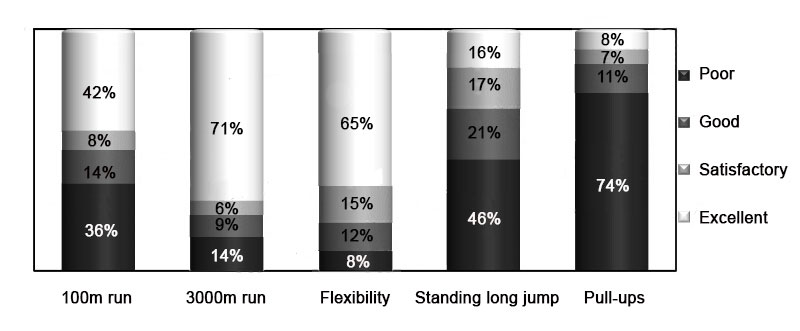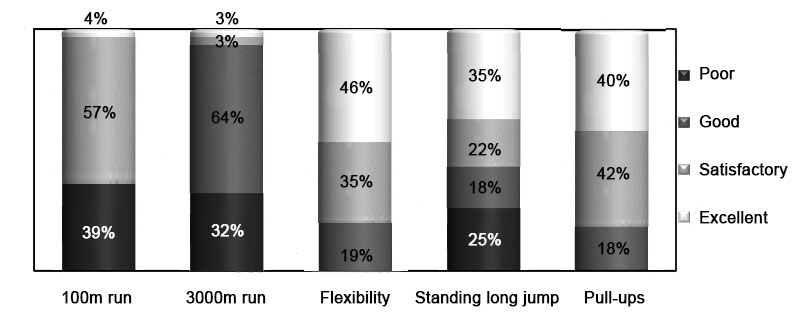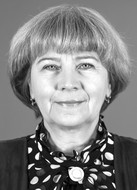Combined effects of natural factors on students' physical and psychomotor development in Russian Far North
Фотографии:
ˑ:
PhD, Associate Professor S.Kh. Mukhametgaliyeva1
PhD, Associate Professor V.I. Kuzmenko1
PhD, Associate Professor N.L. Ivanova2
1Yelabuga Institute of Kazan Federal University, Yelabuga
2Surgut branch of Tyumen Industrial University, Surgut
Keywords: students, northern natural and weather factors, physical development, psychomotor development, negative impacts.
Introduction. Presently, it is one of the pressing issues to study the negative effects of natural factors (atmospheric pressure, air temperature and humidity, solar activity, solar storms and magnetic activity) on the health of those living in extreme conditions of the Far North of Russia and relevant areas [2, 10].
Objective of the study was to highlight the key natural factors of combined effect on the students’ physical and psychomotor development in the Russian Far North; and identify potential negative effects.
Methods and structure of the study. The experiment was conducted at the premises of the Surgut branch of Tyumen Industrial University and involved two groups of students (aged 25-30 years), 50 people each. The groups were formed as follows. Group I was made of the students who have been living in Surgut for 10 years and less, that is, those who had come to the north relatively recently. Group II included the students who have been living in Surgut for more than 10 years, that is, either from birth or from earliest infancy. The study was conducted in five stages. At the first stage, we analyzed the scientific and methodological literature to provide theoretical foundations on the subject matter. At the second stage, the initial indicators of the students’ physical and psychomotor development were measured. At the third stage, carried out in 4 years, the same indicators were measured once again. The fourth stage was devoted to analysis of the research results and their systematization. At the last, fifth, stage, we considered a possibility of using in the educational process the means and methods of physical training to level out the negative influence of environmental effects on the students.
According to the scientific and methodological literature data, Surgut is located in the Khanty-Mansi Autonomous Region - a part of the territory lying in the Far North [10]. These territories, and Surgut in particular, are characterized by the following extreme natural factors: sharp daily air temperature fluctuations, atmospheric pressure and air humidity, severe winter and cold summer, frequent non-periodic geomagnetic field variation, harsh aerodynamic conditions, specific photoperiodicity (insufficient amount of solar radiation) [3].
Considerable and sudden changes in the atmospheric pressure provoke blood pressure spiking, heart rhythm and heart rate disorders, appearance of the signs of general discomfort [8]. Besides, a sharp change in the air pressure causes a decrease in blood oxygen level, which leads to hypoxia in the organs and tissues of the body [7, 9]. Brain cells are the most vulnerable, so even healthy people can experience headaches in response to sharp changes of air pressure.
A sudden temperature shift by more than 7°C within 12 hours can aggravate health problems in people, especially, in those with cardiovascular disorders [10].
Surgut is defined by high air humidity outdoors and low - indoors throughout the cold season. Low air humidity causes dryness of mucous membranes (eyes, nasal pharynx). High air humidity causes dampness that affects man’s temperature resistance [2, 3, 9, 10]. The combination of high air humidity and low temperature is among the most unfavourable factors adversely affecting human health. Also, high humidity can cause aggravation of the cardiovascular and respiratory diseases [6].
Surgut climate is also distinguished by the insufficient solar radiation, which causes hypovitaminosis D in the body, which in turn suppresses the body defense mechanisms, blunts immunity, as well as leads to the onset of symptoms of nervousness and depression. Children and senior people are the most vulnerable to this effect [4].
Frequent non-periodic geomagnetic disturbances have a direct impact on the work of the central nervous, endocrine and cardiovascular systems [1, 2].
Physical development includes two components: physical fitness level and functional development of an individual. In this study, the physical fitness level was assessed based on the norms and requirements of the Russian physical culture and sports complex GTO (Ready for Labour and Defence) [5].
Results and discussion. The physical fitness level of the students in both groups (Figures 1, 2) was determined as follows. The Group I subjects demonstrated better results in such tests as 100m run, 3000m run and flexibility. 100m and 3000m run tests estimate speed motor qualities and endurance, respectively. Therefore, poor test results of the students living in the North for a longer time (Group II) indicated a negative impact of the northern natural factors on the students’ speed and endurance abilities. At the same time, the Group II students demonstrated better results in such tests as standing long jump and pull-ups. The standing long jump test is indicative of the explosive power of legs, and pull-ups test - of strength endurance. So the fact that the students who have been living in the North longer passed these tests better than those of Group I proves that living in the North does not affect man’s strength abilities. Therefore, living in the North has a negative impact on the students’ physical fitness to a degree. That is why in our study we disregarded such standing long jump, flexibility and pull-ups test rates and focused on running (100m and 3000m run tests).

Fig. 1. Physical fitness (Group I)

Fig. 2. Physical fitness (Group II)
The initial (at the beginning of the experiment) and final (at the end of the experiment, in 4 years’ time) indicators of physical fitness of the students are presented in Table 1. Having analyzed Table 1, it can be concluded that the indicators changed for the worse in both of the groups, but to a different degree. At the same time, it was the students living in Surgut for more than 10 years, whose indicators changed more significantly. This is due to the fact that longer living in the North causes more pronounced negative impact of the aggregate natural factors on his physical fitness.
Table 1. Mean physical fitness rates
|
Group I |
|||
|
Tests |
Initial |
Final |
Changes |
|
100m run (s, ms) |
14.45±0.54 |
15.08±0.56 |
0.32±0.28 |
|
3000m run (min, s) |
14.54±1.28 |
16.27±1.27 |
0.27±0.08 |
|
Group II |
|||
|
100m run (s, ms) |
15.21±0.51 |
15.50±0.59 |
1.06±0.12 |
|
3000m run (min, s) |
15.45±1.02 |
16.09±1.04 |
1.44±0.22 |
The results of study of the second component of physical development - functional development are presented in Table 2. As seen from the table, all functional indicators of the students in both groups decreased. Such parameters as heart rate (HR), circulatory efficiency coefficient (CEC) and endurance coefficient (EC) are the indirect indicators of the cardiovascular system functionality. That is why any deviation of these indicators from the norm indicates its malfunction. This means that the HR, CEC and EC values in all students decreased due to the cardiovascular system disorders caused by the unfavourable natural factors of the North. However, it should be noted that more significant changes in these indicators among the students living in Surgut for less than 10 years prove that their bodies were still in the process of adaptation to the Northern conditions and, therefore, were more susceptible to their impacts. It should also be emphasized that a decrease in the Group II students’ respiratory rate (RR), as an indicator of the depth and rhythm of breathing, suggested that their breathing had become shallower in the conditions of the North.
Table 2. Mean functional development rates
|
Group I |
|||
|
Parameters |
Initial |
Final |
Changes |
|
HR |
73.38±1.23 |
75.55±1.26 |
2.17±0.15 |
|
RR |
14.22±0.37 |
15.04±0.35 |
0.82±0.093 |
|
CEC |
3630.54±139.70 |
3689.49±140.61 |
58.95±3.69 |
|
EC |
15.82±0.49 |
16.04±0.49 |
0.21±0.02 |
|
Group II |
|||
|
HR |
78.12±1.33 |
78.70±1.33 |
0.58±0.12 |
|
RR |
15.88±0.76 |
16.56±0.70 |
0.68±0.13 |
|
CEC |
3389.78±112.54 |
3412.11±114.09 |
22.33±5.56 |
|
EC |
17.14±0.51 |
17.28±0.51 |
0.14±0.02 |
The students’ psychomotor abilities were studied using the Schulte table method. As a result, we obtained the following data (Table 3). Both the degree of involvement and mental stability of the students in both groups decreased. Group I had a higher level of mental stability (MS) and a higher degree of involvement (DI) as compared to the students who had been living in the North for more than 10 years. This fact indicates that the northern natural factors also affect the students’ psychomotor development.
Table 3. Mean psychomotor development rates
|
Group I |
|||
|
Indicators |
Initial |
Final |
Changes |
|
DI |
1.045±0.024 |
1.089±0.029 |
0.044±0.020 |
|
MS |
1.0044±0.0218 |
1.0288±0.0222 |
0.0244±0.0029 |
|
Group II |
|||
|
DI |
1.058±0.023 |
1.112±0.025 |
0.054±0.009 |
|
MS |
1.0222±0.0223 |
1.0418±0.0224 |
0.0196±0.0042 |
Conclusions. It was found that the combined adverse effects of the northern natural and weather factors partially affect students’ physical fitness level, as well as their functional and psychomotor development. The degree of impact of these unfavourable conditions of the North on students depends on the duration of their residence in KhMAR-Yugra and other northern territories. In the North students’ health will deteriorate all the time if no physical training and sports activities. Therefore, it is necessary to develop the methods of organization of physical education classes within an educational institution that would help level out the negative impact of the aggregate northern natural and weather factors.
References
- Aghajanyan N.A. Chelovek v usloviyakh Severa [Man in the North]. Moscow: Krug publ:, 1996.
- Bashkatova Yu.V., Karpin V.A. Obschaya kharakteristika funktsionalnykh sistem organizma cheloveka v usloviyakh Khanty-Mansiyskogo okruga – Yugry [General characteristics of functional systems of human body in conditions of KhMAR - Yugra]. Ekologiya cheloveka [Human Ecology], 2014, no. 5, pp. 9-16.
- Zuevskaya T.V., Zuevskiy V.P., Ushakov V.P. et al. Klimaticheskie i ekologicheskie osnovy patologii cheloveka v Khanty-Mansiyskom avtonomnom okruge – Yugre [Climatic and ecological basics of human pathology in KhMAR - Yugra]. XIII Kongress 'Ekologiya i zdorovye cheloveka' [Proc. XIII Congress 'Ecology and human health'], 2008, vol. 1, pp. 159-163.
- Ivanova N.L. Vliyanie pogodnykh faktorov na studencheskuyu molodezh [Influence of weather factors on students]. Nauka i biznes: puti razvitiya, 2015, no. 9(51), pp. 5-7.
- Lubysheva L.I. Vserossiyskiy kompleks GTO kak faktor razvitiya fizkulturno-sportivnoy deyatelnosti vuza [Russian GTO complex as a factor in development of academic physical culture and sports activities]. Sb. nauch. prakt. konf. 'Fizicheskaya kultura, sport, turizm: nauch.-metod. soprovozhdenie' [Proc. sci.-pract. conf. "Physical culture, sports, tourism: scientific-methodological support'], 2014, pp. 184-189.
- Mizun Yu.G. Zdorovye na Severe [Health in the North]. Moscow: Ekologiya i zdorovye publ., 1997.
- Mizun Yu.G. Kosmos i zdorove. Kak uberech sebya i izbezhat bolezney [Space and health. How to protect yourself and be healthy]. Moscow: Veche, AST publ., 1998.
- Novikov V.S., Soroko S.I. Fiziologicheskie osnovy zhiznedeyatelnosti cheloveka v ekstremalnykh usloviyakh [Physiological basics of human life in extreme conditions]. St: Petersburg: Politekhnika-print publ., 2017.
- Solovyev V.S. Adaptatsiya cheloveka v usloviyakh Khanty-Mansiyskogo avtonomnogo okruga – Yugry [Human adaptation in KhMAR - Yugra conditions]. Khanty-Mansiysk, 2010.
- Tsepko O.A. Osobennosti adaptatsii organizma studentov, prozhivayuschikh na territorii Srednego Priobya [Features of students' adaptation in Middle Ob area]. Mater. mezhdunar. nauchno-teh. internet-konferentsii ‘Fundamentalnye i prikladnye aspekty sozdaniya biosferosovmestimykh sistem’ [Proc. Intern. scie.-technical Internet conference 'Biosphere-compatible system design: fundamental and applied aspects'], 2013, pp. 348-350.
Corresponding author: kuzmenko_valya@mail.ru
Abstract
The study analyzes the effects of natural factors on the students’ physical and psychomotor development in the Far North of Russia and relevant areas. Issues of the individual and public health in harsh climatic conditions are always critical as the human life cannot be isolated from the living environment. Applied for the study purposes were the relevant theoretical (analysis, synthesis, classification) and empirical (tests, educational process monitoring, psycho-educational and practice related literature, students’ academic performance, individual and collective experiences of the faculty etc.) research methods, plus the standard mathematical processing toolkit. Objective of the study was to highlight the key natural factors of combined effect on the students’ physical and mental development in the Far North of Russia; and identify the potential negative effects. Students of the Surgut branch of Tyumen Industrial University were subject to the study. The study data and analyses made it possible to list and rate the factors of influence on the students’ physical development, functional and psychomotor development rates in the Far North of Russia.



